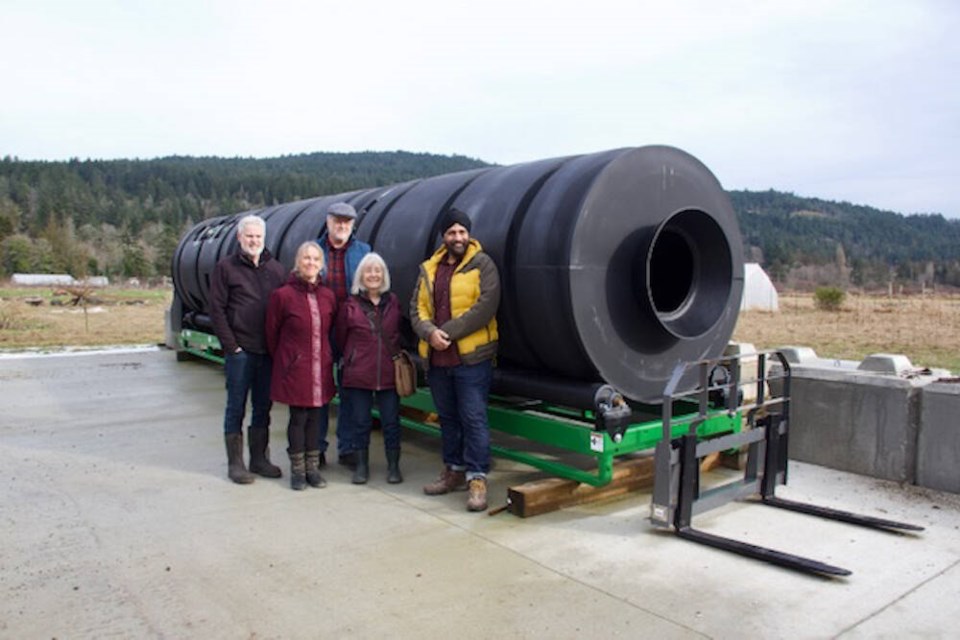Salt Spring Island’s first major composting facility is expected to be rolling and tumbling by summer and producing more than 100 tonnes of material for the island’s gardens and fields.
The rotating-drum system will process waste from the island’s farmer co-operative abattoir, community gardens and food businesses such as grocers and restaurants — materials that are currently shipped off Salt Spring for processing.
The $310,000 composter project at Burgoyne Valley Community Farm is expected to produce a Class A compost for use in agriculture to increase food production, said project manager Kevin Chipperfield.
He said the facility has the capacity to produce 200 cubic metres of compost a year.
An estimated 100 tonnes of compost is ferried to Salt Spring each year for use in organic gardens and other food-producing crops.
“It’s all part of a self-sufficiency strategy for the Island to grow crops and feed the people of Salt Spring,” said Chipperfield, who expects only trace amounts of odour from the rolling-drum, solar-powered facility, which sits on about a half acre on the Burgoyne Farm, at 2232 Fulford-Ganges Rd.
He said the drum is sealed and the continual rolling process keeps the materials aerobic, which prevents strong odours like sulphur that can waft into the air from large stationary compost piles. The plant will also be contained on a concrete pad under a shelter.
The island doesn’t have dedicated green-bin pickups like elsewhere in the Capital Regional District. Rather, garbage is collected by private operators at depots, and large producers of green waste such as restaurants and groceries pay for their own disposal and shipping off island through private contractors.
Gary Holman, Salt Spring director for the CRD, which owns the composter, said most residents do their own composting in gardens and on farms.
He said initially, the composter will handle waste from the abattoir and the 90 community garden plots and commercial organic farmers who lease larger food-production parcels at the 65-acre Burgoyne Valley Community Farm, owned by the Salt Spring Island Farmland Trust.
Another entity of the trust, The Root — a processing, storage and distribution hub for locally grown food expected to be operational this year — will also contribute waste for the composter.
Holman said the composter is one of three key pieces of the Salt Spring Farm Plan for self-sufficiency and climate action that includes The Root and the co-operative abattoir.
“We can initially sell compost to these farmers and hope to expand the site so over time we’re selling materials island-wide,” he said.
Holman said major commercial producers like Country Grocer, which has been involved in the composter planning for years, would be able to drop off their vegetable waste and have it processed to sell in the Salt Spring store. The hospital and schools will also likely be using the facility.
Over time and with various approvals, the composting system could be expanded to include other producers of green waste, Holman said.
Holman said a tipping-fee schedule is being developed for green-waste drop-offs. Together with sales of the finished product, that’s expected to cover operating costs at the facility.
“People are paying $75 a yard for compost — it’s expensive, especially if it’s bagged,” said Holman.
The province announced this week it is providing $170,000 to help finance the collection and compost point at Burgoyne Valley Community Farm. The federal government contributed $100,000 collected through gas taxes and another $40,000 via Agriculture Canada.
Aman Singh, B.C.’s parliamentary secretary for the environment, said the funding will significantly reduce Salt Spring Island’s waste shipping costs, as well as greenhouse gases from transportation.
Sheila Dobie, chair of the Salt Spring Island Farmland trust, said dealing with community-produced food waste without having a composting facility has been an “unresolved challenge” for many years. She said several community organizations, businesses and individuals worked tirelessly over the past decade to make the project a reality.
The Farmland Trust said Salt Spring has about 200 farms, but only 6% of the food that islanders purchase and consume is locally produced.
>>> To comment on this article, write a letter to the editor: [email protected]



